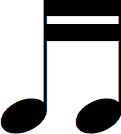A sixteenth note (also called a semiquaver) represents the duration of a quarter of a beat in a 4/4-time signature.

It is identified on sheet music by a filled-in oval notehead at the base of a single straight stem, with two flags. When sixteenth notes appear below the middle line of the staff, they’re drawn with stems to the right of the notehead, facing up. If they appear on or above the middle line, they’re drawn with the stems to the left, facing down.
When multiple sixteenth notes are played next to each other, instead of being displayed with flags, the notes are beamed together.

Practicing Sixteenth Notes
As the name suggests, a sixteenth note is played for one sixteenth of the duration of a whole note. It lasts a quarter of the duration of a quarter note and half of the duration of an eighth note.

A good way to practice is by using a metronome set to 40 beats per minute. Count out loud “1 e and a 2 e and a 3 e and a 4 e and a, 1 e and a 2 e and a 3 e and a 4 e and a…”.
The numbers should fall directly on each beat, with the rest evenly distributed in-between. Then try to strum along, using both down and upstrokes.